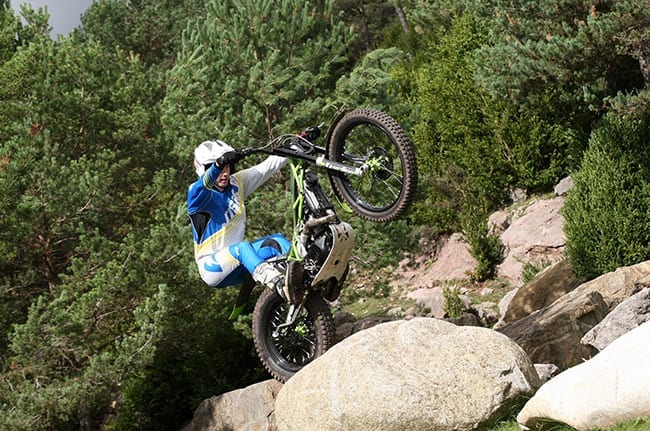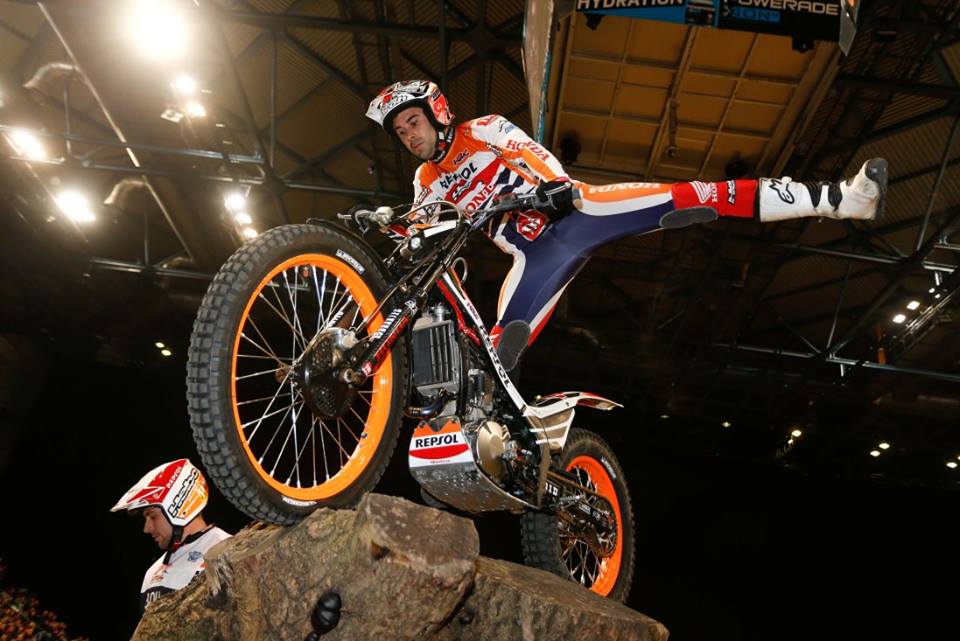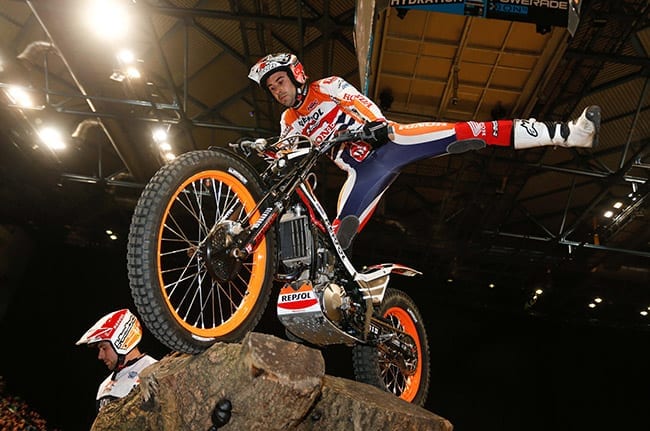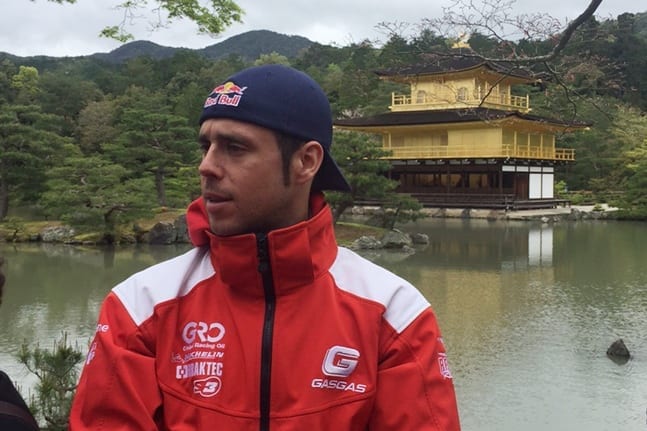Vertigo’s ready for battle
By Team TMX on 16th Oct 15

Ever since the mid 1960s 1965 to be exact when the great Sammy Miller signed for Bultaco Spain has been the prime mover in trials bike development and production. Bultaco, Ossa and Montesa thrived through the 1970s before history took over but then along came new companies Gas Gas, Mecatecno, Sherco, a revived Ossa, Jotagas and now Vertigo.
Vertigo is the brainchild of Barcelona businessman and trials enthusiast Manel Jane who has long harboured the dream of producing his own trials bike. Manel knew exactly what he wanted, to take full advantage of current trials design but to take a significant step forward without getting too radical in a quality package.
It was 2013 when the trials world first officially got to know about the Vertigo project and with Dougie Lampkin having been signed as development rider it was obviously to be taken seriously. The public wanted (expected!) to see Doug on a development bike in the 2014 Scottish but the factory decided the machine was not sufficiently developed for such a high profile launch and Doug won the event on his DL12 machine – which as we know was a thinly disguised Gas Gas.
The pre-production Vertigo prototype was actually sprung on the world in November 2014 at the big Milan Motorcycle Show and the world's press was instantly impressed. It showed a striking looking machine with a clever aluminium and steel tube chassis housing an electronic fuel injected (efi) conventional two-stroke motor with an electric water pump, low mounted fuel tank and conventional suspension and brakes front and back. It struck a good balance between innovation and sound principles.
Just two months later and newly signed factory rider, James Dabill, gave the Vertigo its competition debut at the Sheffield Arena X-trial. The pairing didn't make the final but the machine acquitted itself well, sounded good and the high tech engine management system did its stuff.
The world really sat up and took notice though in May when Vertigo brought six machines to the Scottish Six Days Trial – and Dougie stormed to victory to give the factory a dream debut win. Dabill finished fourth, his ride ruined by a catastrophic time loss on Tuesday while the machines of Paul Dixon, Gaby Reyes and Axel Jane all finished the week. Ironically the only non-finish was by Manel himself and the machine was not at fault. Manel was forced to retire with a back problem, ending his ambition of finishing the Scottish on a bike of his own manufacture.
As Dabill and Francesc Moret continued development at the highest level, in the World Championship, the factory in Barcelona was being geared-up for production. And as production of the Vertigo is now a reality, the target set at a realistic ten-machines per day, this brings us nicely round to the first public test...
Ben Hemingway, a hugely experienced off-road ace who has ridden both trials and enduro to International level, his successes including several runner-up berths in the Scottish Six Days, was an obvious choice to represent TMX.
So Ben, a regular globe-trotter as he pursues his busy competition calendar, found himself stopping-off in rural Spain recently, at Manel Jane's personal trials testing ground which at around 1,000 hectares in total, is not to be sneezed at.
The basic Vertigo design was clearly on the button right from the start as the production machine remains remarkably close to the prototypes as shown at the Milan Show less than 12 months ago.
That eye catching chassis featuring a fully triangulated steel tube lattice, married to an aluminium base, houses that six speed two-stroke motor plus of course the associated efi electronic hardware. The radiator is manufactured in a V-shape to optimise efficiency.
Fuel is carried low down in the chassis in a ‘plastic' tank at the rear of the engine and the advantage of this is that it not only lowers the centre of gravity, the balance of the machine doesn't alter regardless of the fuel level.
The exhaust was probably the final piece of the jigsaw to be finalised as we have seen several variations on the factory machines over the year. This is of course the whole point of prototype machines. The engineers were naturally seeking maximum performance as well as an acceptable noise level which explains the constant tweaking in order to get to full production spec.
The clever bit is of course the efi and the all important ecu which controls the engine management. It operates through various sensors, including the electric water pump, which is a step forward all on its own. The pump will only cut in when it is required, making for quick warm-up and very efficient operation. A mechanical pump spins on a permanent basis and works harder the faster the engine revs. When on the road at speed, with plenty of air getting to the radiator, the pump may not be needed at all.
Suspension is tried and trusted with top quality Tech forks up front and a conventional linkage system at the rear controlling an aluminium swinging arm. The rear shock is a quality Reiger unit as used very successfully on top of the range Gas Gas machines.
The majority of the cycle parts are, as expected, industry standards with the likes of Morad rims and Braktec brakes which are absolutely fine.
Says Ben: "Like many people I have followed the development of the Vertigo all year and witnessed Dougie's Scottish win at close quarters, being in the same riding group, so I was really keen to get a ride on the production bike. I didn't really know what to expect and to be honest I was surprised at how good it actually felt.
"Starting with the chassis the initial feel of the bike was how very well balanced it felt, very easy to ride and it handled well in the mixed streams and banking sections laid out for us. The steering was light and easy and the bike didn't try to fold or push on full lock, it just felt very natural. The low mounted fuel tank obviously helps with the excellent balance.
"On the suspension front the Tech forks felt really good up front, working well and in my opinion complimented the overall feel of the chassis. The rear shock is a Reiger unit and works really well and can cope with anything you throw at it. The harder you hit steps the better it reacts. The rear end feels good and as it has a similar linkage to most other production bikes around it is very capable.
"To start the bike, just one press of a button wakes up the fuel pump and then an easy push on the kickstart – like a Montesa 4RT which also runs efi – brought the motor to life.
"Once running there are no fewer than four fuel mixture modes that you can alter to suit conditions on the ground, whether the going is grippy or slippery and even fine tune for altitude.
"The efi is tuned to programme the power differently in the lower four (trials) gears. Power is reduced in the lower gears to allow maximum traction and increased as you move up through the gearbox. To be honest I couldn't tell this when riding it.
"At low revs, the bottom end power was strong and smooth but I found that mid to top end power is not its strong point. Manel Jane is an experienced trials rider and he always planned for the production bike to be rideable by all – not just elite riders.
"An engine characteristic I did like was that there was actually notable engine braking. It certainly isn't as strong as you get with a four-stroke but was still definitely noticeable. I am guessing that this is something to do with the efi and can probably be tuned in or out with programming. Whatever, I found it a positive attribute and made the Vertigo feel very controllable in tricky conditions.
"This was the first machine I have ridden that is fitted with a diaphragm clutch, which is similar to that used by Gas Gas. I found it took a bit of acclimatising to (after a Beta clutch) but I experienced no drag and it was very light on the finger, which is pretty much what you are all hoping for.”


